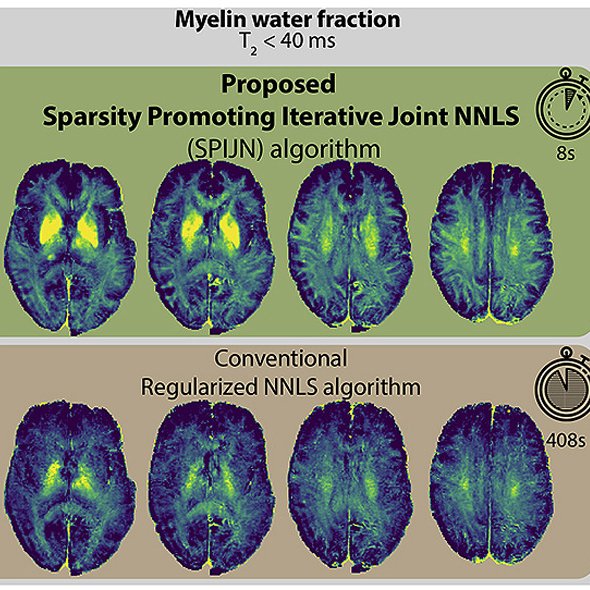Paper Martijn Nagtegaal on "Myelin water imaging from multi-echo MR relaxometry data using a joint sparsity constraint" is published in NeuroImage
Myelination is a crucial aspect of brain development and is essential for the functioning of the nervous system. Demyelination, on the other hand, is a pathological process that plays an important role in certain diseases such as multiple sclerosis. Accurate measurement of myelin content has the potential to increase our insights into several disease processes. Magnetic resonance imaging (MRI) enables imaging of features related to (de-)myelination in vivo. Martijn Nagtegaal uses dictionary matching and a joint sparsity multicomponent T2 fit to obtain MWF maps.
Abstract
Demyelination is the key pathological process in multiple sclerosis (MS). The extent of demyelination can be quantified with magnetic resonance imaging by assessing the myelin water fraction (MWF). However, long computation times and high noise sensitivity hinder the translation of MWF imaging to clinical practice. In this work, we introduce a more efficient and noise robust method to determine the MWF using a joint sparsity constraint and a pre-computed B1+-T2 dictionary.
A single component analysis with this dictionary is used in an initial step to obtain a B1+ map. The T2 distribution is then determined from a reduced dictionary corresponding to the estimated B1+ map using a combination of a non-negativity and a joint sparsity constraint.
The non-negativity constraint ensures that a feasible solution with non-negative contribution of each T2 component is obtained. The joint sparsity constraint restricts the T2 distribution to a small set of T2 relaxation times shared between all voxels and reduces the noise sensitivity.
The applied Sparsity Promoting Iterative Joint NNLS (SPIJN) algorithm can be implemented efficiently, reducing the computation time by a factor of 50 compared to the commonly used regularized non-negative least squares algorithm. The proposed method was validated in simulations and in 8 healthy subjects with a 3D multi-echo gradient- and spin echo scan at 3 T. In simulations, the absolute error in the MWF decreased from 0.031 to 0.013 compared to the regularized NNLS algorithm for SNR = 250. The in vivo results were consistent with values reported in literature and improved MWF-quantification was obtained especially in the frontal white matter. The maximum standard deviation in mean MWF in different regions of interest between subjects was smaller for the proposed method (0.0193) compared to the regularized NNLS algorithm (0.0266). In conclusion, the proposed method for MWF estimation is less computationally expensive and less susceptible to noise compared to state of the art methods. These improvements might be an important step towards clinical translation of MWF measurements.
